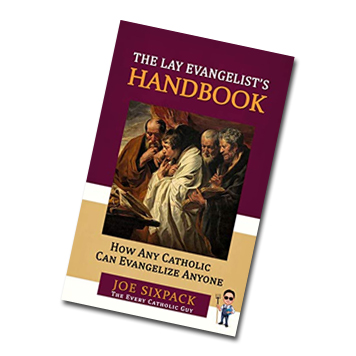“What Is Historical Church Teaching On Contraception?”
By BRIAN CLOWES
(Editor’s Note: Brian Clowes has been director of research and training at Human Life International since 1995. For an electronic copy of chapter 21 of The Facts of Life, “Contraception,” e-mail him at bclowes@hli.org.)
+ + +
Part 1
“Contraception cannot be an expression of total self-giving, because in contraception, something is done to oneself to destroy the power to conceive a child. That same selfishness that wants to prevent the child by contraception will grow until it wants to kill the child already conceived. We must fight selfishness with a true, generous, and sacrificing love” — Mother Teresa of Calcutta.
+ + +
There is a surprising amount of controversy swirling around the Catholic Church’s teachings on contraception, but there certainly shouldn’t be.
Some people say that we can use our consciences to decide for ourselves whether or not to use birth control, regardless of what the Church teaches. Some assert that the Church hierarchy, composed entirely of men, hates women’s sexuality and therefore seeks to control and suppress it. Yet others claim that the Church approved of birth control in the past, and is therefore being inconsistent in its current prohibition of the practice.
However, history shows that the teachings of the Catholic Church on contraception have always been consistent and could not be clearer. Only a person who is willfully blinding himself or herself to the facts could make the claim that there is “room for a diversity of opinion” within the Catholic Church on either contraceptive or abortifacient methods of birth control, regardless of the justifications they advance.
The Church is the guardian of our interpretation of the natural law. Since the natural law was given to us by God, the Church does not have the authority to change its fundamental moral principles. The Church, of course, does clarify certain matters in the light of new knowledge, but the fundamental precepts of the natural law in Church teaching remain unchanged. As we have seen, these precepts include a general prohibition on any mutilation or disabling of any of the organ systems of our bodies.
From the time of its founding, the Catholic Church has universally condemned contraception. Athenagoras, St. Ambrose, St. Augustine, Barnabas, St. Basil the Great, Caesarius, Clement of Alexandria, Ephraem the Syrian, Epiphanius, St. Jerome, St. John Chrysostom, Hippolytus, Lactantius, Minucius Felix, Origen of Alexandria, Tertullian, and the assembled bishops at the First Council of Nicaea were some of the Early Church Fathers who wrote and spoke against contraception.
As the various Protestant denominations formed, their founders and leaders also condemned contraception in the strongest possible terms. John Calvin called the practice of contraception “condemned” and “doubly monstrous,” and saw abortion as “a crime incapable of expiation.” John Wesley said that contraception is “very displeasing to God, and the evidence of vile affections.” Martin Luther called those who used contraceptives “logs,” “stock,” and “swine.”
Virtually every leader of every Protestant denomination condemned contraception explicitly and forcefully in his sermons and writings. These included Anglicans Henry Alford, William Dodd, Joseph Hall, and Christopher Wordsworth; Calvinists Jacob Alting, Robert S. Candlish, and Cotton Mather; Evangelicals Keith Leroy Brooks and Thomas H. Leale; Huguenot Jean Mercier; Lutherans Johann Albrecht Bengel, Johannes Brunnemann, and Abraham Calovius; Methodists Adam Clarke and Richard Watson; Nonconformists Henry Ainsworth, Daniel Defoe, and John Gill; Presbyterians John Brown, Robert Dabney, and Melancthon W. Jacobus; and Puritans Richard Stock and John Trapp.
In fact, it is impossible to find any early Protestant minister speaking out in favor of contraception.
The Fatal Error. Until 1930, all Christian churches were unanimous in their opposition to artificial means of birth prevention, except for a few small fringe groups like the Unitarians and the Quakers. As recently as 1920, the Anglican Church had stated: “We utter an emphatic warning against the use of unnatural means for the avoidance of conception, together with the grave dangers — physical, moral, and religious — thereby incurred, and against the evils with which the extension of such use threatens the [human] race.” The previous year, Anglican C.K. Millard, who had recognized the danger threatening his church, warned:
“Although many Malthusians are rationalists, they are well aware that without some religious sanction their policy could never emerge from the dim underworld of unmentioned and unrespected things and could never be advocated openly in the light of day. To this end birth control is camouflaged by pseudo-poetic and pseudo-religious phraseology, and the Anglican Church is asked to alter her teaching. Birth controllers realize that it is useless to ask this of the Catholic Church, but as regards the Church of England, which makes no claim to infallibility, the case is different, and discussion is possible.”
The first crack in the dam was Resolution 15 of the Anglican Bishops’ Lambeth Conference of August 15, 1930, which read as follows:
“Where there is a clearly felt moral obligation to limit or avoid parenthood, the method must be decided on Christian principles. The primary and obvious method is complete abstinence from intercourse (as far as may be necessary) in a life of discipleship and self-control lived in the power of the Holy Spirit. Nevertheless, in those cases where there is such a clearly felt moral obligation to limit or avoid parenthood, and where there is a morally sound reason for avoiding complete abstinence, the Conference agrees that other methods may be used, provided that this is done in the light of the same Christian principles. The Conference records its strong condemnation of the use of any methods of conception-control for motives of selfishness, luxury, or mere convenience.”
A careful reading of this statement clearly exposes the familiar semantic tools used by the Culture of Death. Upon first reading, Resolution 15 sounds smooth, firm, and compassionate. But it places no real boundaries on the behavior of the Christian, instead leaving all sexual behavior to be judged by the individual’s conscience, regardless of whether it is formed or unformed. Additionally, the language of Resolution 15 is fuzzy and imprecise, providing no real guidance to someone seeking the truth. Today, liberal denominations use similar language to justify abortion and euthanasia.
The “Hard Cases.” Just as pro-abortionists used the “hard cases” to impose abortion on demand — and just as pro-euthanasia activists are now using them to lobby for euthanasia on demand — pro-contraception activists used them to pave the way for easy access to birth control in both the secular and religious spheres.
The United States Federal Council of Churches (now the National Council of Churches) had been waiting for a specific denomination to take the lead in “modernizing” Christendom’s stand on birth prevention. Soon after the Anglican capitulation, it endorsed “the careful and restrained use of contraceptives by married people,” while at the same time conceding that “serious evils, such as extramarital sex relations, may be increased by general knowledge of contraceptives.”
The FCC demonstrated its appalling lack of understanding of human nature by stating that it “believe[s] that the undesirable use of contraceptives will not be indulged in by most people, and that if the influence of religion and education is properly developed the progress of knowledge will not outrun the capacity of mankind for self-control.”
The reaction of many to the statements by the Anglican Church and the Federal Council of Churches was immediate and vigorous. In the early 1930s, priests and ministers had not yet given up their right — and their duty — to be forceful voices in the public square. These brave men predicted that easy access to artificial birth control would lead to abortion and the destruction of the family. Their spokesmen, experienced students of human nature, understood the “slippery slope” concept, and clearly recognized that we had taken the first fatal step.
Dr. Walter A. Maier, a professor at the Concordia Lutheran Theological Seminary in St. Louis, wrote:
“Birth Control, as popularly understood today and involving the use of contraceptives, is one of the most repugnant of modern aberrations, representing a 20th Century renewal of pagan bankruptcy.”
The April 2, 1931 issue of The Presbyterian said that “its [Federal Council of Churches] recent pronouncement on birth control should be enough reason, if there were no other, to withdraw from support of that body, which declares that it speaks for the Presbyterian and other Protestant churches in ex cathedra pronouncements.”
A Disgusting Movement
And Bishop Warren Chandler of the Methodist Episcopal Church, one of the most strident voices against contraception, preached:
“The whole disgusting [birth control] movement rests on the assumption of man’s sameness with the brutes. . . . Its [the Federal Council of Churches] deliverance on the matter of birth control has no authorization from any churches representing it, and what it has said I regard as most unfortunate, not to use any stronger words. It certainly does not represent the Methodist Church, and I doubt if it represents any other Protestant Church in what it has said on this subject.”
Christians were not the only ones protesting the encroachment of contraception on family life. As we shall see in the next article, even the secular press was outraged.










